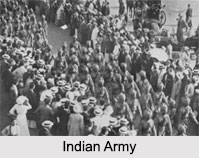 The Indian Army during British rule in India comprised of various regiments or military units. One such unit was Infantry, which was divided into "Regular" and "Auxiliary Force". The Auxiliary Force comprised of regiments called the "Punjab Regiments". These Punjab Regiments are described below.
The Indian Army during British rule in India comprised of various regiments or military units. One such unit was Infantry, which was divided into "Regular" and "Auxiliary Force". The Auxiliary Force comprised of regiments called the "Punjab Regiments". These Punjab Regiments are described below.
1st Punjab Regiment
1st Punjab Regiment, an infantry of the British Indian Army was functional from 1922 to 1956. The establishment of British rule in south and central India is attributed to the contributions of this regiment. Some of the campaigns in which the regiment participated were the Battle of Wandiwash (1760), Siege of Madura (1763), First Mysore War (1767-1769), Third Mysore War (1789-1792), Fourth Mysore War (1798-1799), Second Mahratta War (1803-1806), Anglo-Nepalese War (1814-1816), Third Maratha War (1817-1819) and First Burma War (1824-1826).
2nd Punjab Regiment
2nd Punjab Regiment, an infantry of the British Indian Army was functional from 1922 to 1947. A galley with a bank of oars and sail is regarded as the insignia of this regiment. The regimental centre of the unit was at Multan. Its motto was "Sthal Wa Jal" meaning "By Land and Sea" in English.
8th Punjab Regiment
8th Punjab Regiment, a line infantry of the British Indian Army was functional from 1922 to 1947. Some of the campaigns in which this unit participated were Second Poligar War (1801), Second Anglo-Maratha War (1803-1805), Travancore War (1808-1809), Third Anglo-Maratha War (1817 to 1819), Third Kandy War (1818), Coorg War (1834) and Indian Rebellion of 1857.
14th Punjab Regiment
14th Punjab Regiment, an infantry of the British Indian Army was functional from 1922 to 1947. Some of the campaigns in which this unit participated were Indian Mutiny (1857-1858), Second Anglo-China War (1860-1862), Bhutan War (1864-1866), Abyssinian Campaign (1867- 1868), Lushai Expedition (1871), The Boxer Rebellion (1900), First World War (1914-1918), Third Afghan War (1919) and Second World War (1939-1945).
15th Punjab Regiment
15th Punjab Regiment, an infantry of the British Indian Army was functional from 1922 to 1947. Its regimental centre was Sialkot. Some of the campaigns in which this unit participated were Indian Mutiny (1857-1858), Second Anglo-China War (1860-1862),
Bhutan War (1864-1866), Lushai Expedition (1871), Second Afghan War (1878-1880),
Third Burma War (1885-1887), Somaliland Campaign (1901-1904), Chinese Revolution of 1911and First World War (1914-1918).
16th Punjab Regiment
16th Punjab Regiment, an infantry of the British Indian Army was functional from 1922 to 1956. It"s regimental centers were Multan and Sialkot. The campaigns in which this unit participated were Indian Mutiny (1857-1858), Bhutan War (1865), Second Afghan War (1878-1880), Third Burma War (1885-1887), First World War (1914-1918), Third Afghan War (1919), Second World War (1939-1945) and Kashmir War (1948).



















